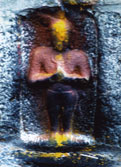| |
HURRICANE KATRINA - ARE THERE ANY LESSONS TO BE LEARNT ?
Last month, we carried a comprehensive cover story on the Mumbai Floods. The purpose of that was not only to highlight the magnitude of the disaster (one metre of rain fell in just one single day!) but also to report on the wonderful Sai Seva that was done following that disaster. This month we are doing a feature on Hurricane Katrina that has caused unprecedented havoc in a few States in USA , bordering the Gulf of Mexico . Readers might wonder why. The answer is simple. Every disaster is a wake-up call for humanity, and we would do well to listen and read the signals.
About Hurricanes
The term hurricane is derived from the word Huracan, believed by ancient aboriginal tribes that lived in Central America, to be the god of evil.
Cyclonic storms of which a hurricane is one example, form over tropical waters, in areas of high humidity, light winds and warm sea surface. Such conditions prevail in certain seasons over some regions of the oceans on earth.
The starting point of such storms is the formation of what is called convergence. In this, winds blowing in different directions come together. When this happens, there is what is called a tropical disturbance that manifests as a cluster of thunderstorms. Under favourable conditions, the tropical disturbance can become better organised; that is to say, there is a drop in pressure accompanied by cyclonic circulation of the atmosphere in that region. A lot of heat is released, as a result of which the system rises, expands and cools, and in favourable circumstances, causes a chain reaction. In the process, the wind speed increases and can attain awesome speeds.
As a hurricane moves closer to land, there is an accompanying storm surge. This is the name given to the rise in the level of the ocean, which can be quite high, sometimes as high as 30 feet. This rise is not local; rather, a dome of water is formed which can be say, 30 feet high and as wide as 50 miles wide! That kind of water surge can sure cause heavy damage.
The cyclonic storms that form in the Atlantic are tracked very scientifically, and graded in categories according to the power they pack.
| HURRICANE
CATEGORY |
WIND SPEED
[MILES/HOUR] |
STORM SURGE
[FEET] |
|
74 – 95 |
4 – 5 |
|
96 – 110 |
6 – 8 |
|
111 – 130 |
9 – 12 |
|
131 – 155 |
13 – 18 |
|
MORE THAN 155 |
MORE THAN 18 |
|
|
|
Hurricane and Tsunami – A Comparison
We explain what a hurricane is, and the kind of punch it can pack in the column on the left. Some people have asked us: “Which is more devastating? The tsunami or the hurricane?”
Both are ferocious and devastating, each in its own way.
The tsunami has a very long reach, as we saw in the case of the Indian Ocean Tsunami that struck on the morning of 26th December, 2004. [Download our issue on Tsunami].
By contrast, the hurricane impacts one region, causing extensive damage there. In addition, whereas the tsunami dissipates within a kilometre or so of the coastline, the hurricane can and often does penetrate deep inland; maybe the winds might lose power, but the hurricane can still deposit a lot of rain, causing extensive flooding.
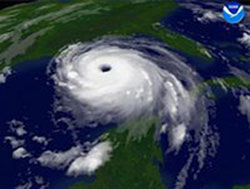 This Year, Katrina This Year, Katrina
Every year, there is a storm season in certain parts of the world; that is when conditions are favourable for hurricanes, cyclones and typhoons to form. Hurricane Katrina followed an interesting trajectory.
Originating in the Atlantic Ocean, it made its first landfall on the east coast of Florida, then cut through the southern part of the peninsula, and entered the sea again, that is, the Gulf of Mexico. Here the conditions were just right for it to grow, and grow it did, to the level of a category 5 hurricane.
HURRICANE NAMES
In India, the cyclone season coincides roughly with the North East Monsoon, which usually extends from mid-October to mid-December. The cyclones come and go, but they are not given names; in fact, they are not even given serial numbers! That is the way it has always been. Where hurricanes are concerned, they have a naming system.
Apparently, there was always a tradition for naming hurricanes but it was only when meteorologists took to the serious tracking of hurricanes when they moved forward, that the naming business became serious.
Until World War II, hurricanes were given masculine names. In the early 1950’s the weather services began naming storms alphabetically and only with female names. By the late 1970’s this practice was replaced with alternating masculine and feminine names [gender equality?!]
Presently, the names are chosen by the World Meteorological Organisation. |
|
|
|
|
Initially, the weather forecasters thought the hurricane would make a direct impact on the city of New Orleans but at the last minute, the hurricane curved slightly towards the east and, missing New Orleans, hit another place [See the image on the left]. After that, it moved deep inwards, losing wind power but dropping a lot of rain all the way. It is interesting that though the hurricane missed New Orleans, it is that city that is very much in the news, long after the hurricane has gone. Why? That is what we shall consider next. |
New Orleans – Waiting to Happen
Mississippi is one of the great rivers of the world. It flows into the Gulf of Mexico, right near the place where New Orleans is. Some distance away from the river is a big lake, Pontchartrain. For thousands of years, the river has been depositing silt, forming a delta. Thus, in the region where New Orleans is located, there are these three agencies, the river, the lake, and the delta. In addition, there is also the sea itself to the south of the delta. Added to all these, when there is a storm, there are fierce winds combined with downpour and storm surges.
New Orleans in USA
|
 |
 |
| |
The State of Louisiana in USA |
The City of New Orleans in Louisiana, USA |
History of New Orleans
The city of New Orleans was founded by the French in 1718, and given the name Nouvelle Orleans, after the city Orleans in France located south of Paris. The original settlers found it to be a lone high ground in a flood-prone region, adjacent to the banks of the Mississippi river. It was also close to a trading route between Mississippi river and Lake Pontchartrain, followed by the Red Indians.
In the beginning, the area was occupied mainly by fur trappers and traders. In 1711, a French priest-chronicler described the place as malaria infested, full of serpents and alligators. One year later, New Orleans became the capital of French Louisiana.
In 1763, the colony was ceded to Spain but no Spanish Governor came to establish office until 1766. In 1795, the Spainish allowed the US the right to use the port. The colony reverted to French rule in 1801 when Napoleon conquered Spain. Barely two years later, Napoleon sold Louisiana along with other French possessions in America in what has come to be called the Louisiana Purchase. From that day, New Orleans became a part of the United States of America. |
|
|
|
New Orleans is located right where these forces act on each other. That is why the city has been described as a city waiting for a disaster to occur. The region where the city is located is actually below the level of the lake, the level of the river and also the level of the sea! It is thus in a bowl. How come then the city was not drowned?
That is because of some protection walls called levees. There are levees that protect the city from Lake Pontchartrain, and also from the river. The delta provides some marginal protection from the sea.
Despite all this, the city is not quite safe. There is a constant tussle between the sea and the river; the river tries all the time to build a delta while the sea tries to encroach.
As for the lake, it is waiting to spill over. The bunds or levees, call it what you will, try to prevent that, but the cure also is a problem!
Thanks to the bund, the level of water in the lake can rise beyond natural limits; this means that if there is a breach, a tremendous amount of water can enter the town and flood it. And that precisely is what happened recently.
The hurricane caused a storm surge that breached some portions of the levees on the lake, and water from the lake began to pour into the city.
|
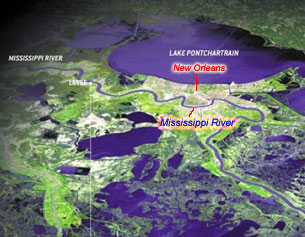
|
|
They Predicted It In 2001
It is not as if people did not know that this would happen. In fact, as early as 2001, an article in the Scientific American entitled “Drowning New Orleans” said:
"The city lies below sea level, in a bowl bordered by levees that fend off Lake Pontchartrain to the north and the Mississippi River to the south and west. And because of a damning confluence of factors, the city is sinking further, putting it at increasing flood risk after even minor storms. The low-lying Mississippi Delta which buffers the city from the gulf, is also rapidly disappearing. A year from now another 25 to 30 square miles of delta marsh - an area of the size of Manhattan - will have vanished. An acre disappears every 24 minutes."
|
|
| |
As you can see, in the above image, New Orleans is much below sea level
and it is actually the levees
which protect it from the river and the lake on both sides.
|
The Scientific American not only warned that a direct hit by a hurricane is inevitable, but also described what the human and economic costs would be. Alas, all that the journal had predicted has come true. This raises many issues, some of which we shall touch upon shortly. But first a few remarks about the disaster itself.
No Rain, No Storm, but New Orleans is Flooded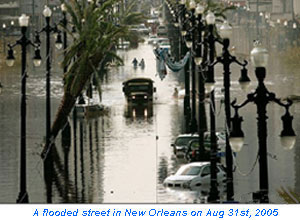
As already remarked, Katrina missed New Orleans but the storm surge breached the levees and the flooding started. The lake simply started pouring into the city, and there was this crazy sight – no downpour, no storm and yet the city was getting flooded; in a sense, it was like what happened during tsunami time. Thanks to the agents of destruction located all around the bowl in which New Orleans is situated, and the city almost drowned.
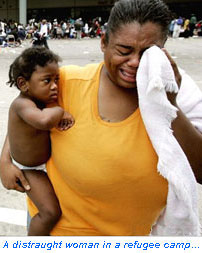
The destruction was severe, and it stunned America. Inevitably, there was acute human distress. Distress is the same everywhere, but America had not seen anything like this within its own frontiers.
News correspondents kept shaking their heads in wonder and said: “This is America! How can we have refugee camps of the type we see in the Third World ?!” But that is the way it is; death and Nature’s fury do not make any distinctions.
Much has been said about many of the things that happened after the disaster, the agony of the suffering, the late arrival of help, and so on. We shall not comment on those aspects since they do not concern us. But there is one aspect that needs our attention, and that is connected with pollution.
To see more images of Katrina devastation, go here.
Pollution – New Orleans New Problem
 Into the bowl in which New Orleans once sat in all its glory, water first poured in from the lake and the river. This water drowned most of the city and as a result, there was a lot of oil pollution, oil from drowned trucks and cars, oil from furnaces in the houses, oil from factories, oil that had leaked from refineries that had suffered damage and so on. Into the bowl in which New Orleans once sat in all its glory, water first poured in from the lake and the river. This water drowned most of the city and as a result, there was a lot of oil pollution, oil from drowned trucks and cars, oil from furnaces in the houses, oil from factories, oil that had leaked from refineries that had suffered damage and so on.
Next, there was pollution from heavy metals such as lead from paint covering walls, cadmium and mercury from computers, and so on.
Added to all this was sewage, garbage from homes, hotels and so on. As if this was not enough, there was the additional complication from dead bodies, floating all over the place.
In this deadly brew, microorganisms went to work and started breaking down many of the complex molecules that formed a part of the garbage. This was facilitated by the bright sun shining from above. This molecular reduction was accomplished by the bacteria in the water, using up whatever oxygen there was in the polluted water.
Why is all this important? It is important because the water accumulated in the city is now being pumped into Lake Pontchartrain – this is how the city is being drained. But will this not harm the ecology of the lake? Some say the lake would heal itself but others argue that if water deficient in oxygen is pumped into the lake, then it would kill the fish, that is, if the heavy elements fail to do so! |
Nature’s Fury - Due to Man’s Folly
What it all shows is that while scientific and technological knowledge may assist progress so-called, it also tends to push wisdom into the backburner. Right now when there is talk of rebuilding New Orleans, many people are asking: “Should we commit all the old mistakes over again? Should we not learn to respect Nature and be in harmony with her?”
We are not sure if those voices would prevail; in fact, they may not even be heard. But they need to be, and it is to stress that fact that we are presenting this article. Yes, the time has come ask seriously: How long can we go on defying Nature and acting against Her?
It is becoming increasingly clear that many of the problems that humanity is facing now have been created by man failing to live in equilibrium with Nature. For example, after the recent tsunami, it was pointed out by many ecologists that the destruction in many places would have been much less if the mangroves along the coastline had not been recklessly destroyed to make way for fish and prawn farms – this was the finding in India at least.
|
 |
The Increasingly Disappearing Indian Tiger
Talking of being in equilibrium, there was recently a heated debate on one of the radio channels in India about the vanishing Indian tiger. In 1939, it was estimated that there were about 40, 000 of these big cats in India. Jim Corbett, the famous British hunter, was worried about the tiger population shrinking, and initiated moves to preserve the tiger. World War II intervened, after which India was partitioned. The country then became involved with so many social problems that people forgot their national animal, and the tiger population came down to an alarming level – just a couple of thousands. |
Even as late as 1950, tigers could be seen here and there occasionally. We are sure readers must be aware of how a tiger in the vicinity of Puttaparthi was killed by a British officer. The British Officer, whose jeep did not move after the killing, was surprised when Swami Himself came there and said,
"I stopped the jeep at this place, for it is a mother, whose three small cubs are at this very time loudly wailing and calling out to her, that you are carrying. Go back! Recover those cubs and gift them to some zoo where they will be well looked after. And do not shoot wild beasts again, for they have caused you no harm. Why do you kill them, surround them and lay traps to catch them. Shoot them instead with a more superior weapon, your camera. That won't maim or kill them."
Mr. Kondal Rao, who has worked on all of Swami’s water projects, says how when he was a young engineer and had to travel on work down the Godavari River on a boat, he would occasionally see a tiger coming down to the river bank to drink water.
When the tiger population crashed, the Government woke up, and a serious effort called Project Tiger was mounted. After that, the tiger population did climb up to about 3000. But lately, there has been an alarming amount of poaching, and in fact in one so-called tiger reserve, it was found one day that there were no tigers at all. This was incredible – the tiger was supposed to be a protected species but it had vanished, thanks to poaching.
|
 |
The Save Tiger Debate
Let us get back to the radio debate. It was a heated affair; most people were in favour of saving the tiger but the views expressed about the methods varied widely. The issue was the following: It was said that the space available for the tiger had shrunk abnormally and that therefore all humans must get out of the forests (that mercifully still remain). In the rich countries, people do not live in forests anymore but in India, a lot of tribals still do.
One idea that is being floated is that the tribals must all be moved out. Might seem like a good idea to get humans out and leave the jungle all to the tiger but there is a big problem; the tribals have been living in the forests for centuries; and there are ten million of them! How to move them all out? Where would they be located? What about jobs for them? Would they like to leave the forest? And so on.
One side argued: “Listen, don’t try to throw the tribals out of the forest. They have lived in the forest for thousands of years and know better than all of us how live in harmony with everything in the forests, including the animals.”
The other side says: “That was long ago. Nowadays, they help with the illegal logging of trees and also in the poaching of animals. They are poor, and can be easily tempted with money.”
|
The Avathar on Natural Disasters
This is an excerpt of the extended 2½ hour interview given by Bhagawan Baba to the Editor-in-Chief, Sri R.K. Karanjia of Blitz News Magazine in September of 1976:
Karanjia: The critics of Swamiji asks why Sai Baba does not help people in distress by bringing rains in times of drought or creating food where there is famine by means of his Sankalpa Shakti (divine will-power)?
Cannot an Avatar help humanity to control the natural forces and prevent calamities like earthquakes, floods, droughts, famine and epidemics?
Baba: This is precisely what I am doing by incarnating or rousing the indwelling God in man to overcome such calamities like Earthquakes, floods, droughts, and epidemics. There are two ways in which an 'Avatar" can help people:
An instant solution as against a long term one.
Any instant solution would go against the fundamental quality of Nature itself as well as the "Karmic" law of cause and effect.
Most of people live in the material world of the desires and egos, which is governed by this law. They reap the fruits of their actions. This brings about their evolution or devolution. If the "Avatar" intervenes to instantly solve their problems, it would stop all actions development, even evolution.
This solution can be ruled out, because it totally negates the natural laws.
The other and more effective alternative presents a long-term solution, whereby the "Avatar" leads the people themselves to a higher level of consciousness to enable them to understand the truth of spiritual laws so that they may turn towards righteousness and steadfastly work for better conditions.
This will relate them back to Nature and the Karmic law of causation. They would then transcend the cycle of cause and effect, in which today they are involved as victims and thereby command and control the natural forces to be able to avert the calamities you mention.

Karanjia: You mean that you are presently raising the consciousness of mankind to a godlike condition to enable them to command their own destiny?
Baba: Exactly. They will become shareholders of My Sankalpa Shakti (Divine power, universal energy). I have to work through them, rouse the indwelling God in them, and evolve them to a higher Reality in order for them to master the Natural laws and forces.
If I cure everything instantly, leaving the people at their present level of consciousness, they would soon mess up things and be at one another's throats again, with the result that the same chaotic situation would develop in the world....
Suffering and misery are the inescapable acts of the Cosmic drama. God des not decree these calamities, but man invites them by way of retribution for his own evil deeds....
So, finally, if the Avatar brings the calamities to an immediate end (which I can do, when there is great need) the whole drama of creation with its Karmic law will collapse.
Remember, these calamities occur not because of what God has made of man, but really because of what man has made of man.
Therefore, man has to be unmade and remade with his ego destroyed and replaced by a transcendental consciousness, so that he may rise above the Karmic bondage to the freedom of averting such disasters. This is the work of the Avatar, which I am presently doing.
- God Lives In India, Pg 18-19. |
|
|
The Common Factor of All Disasters
If you look carefully behind the disaster caused by Katrina in New Orleans, the tsunami disaster in some parts of Asia, the near-extermination of the tiger in India [and many other such problems], you would find that the common factor is the failure of man to live in harmony with Nature. Partly it is due to the growth of the population and partly it is also due to man wanting to “tame” Nature so that he can have his way.
As was pointed out in the cover story on the Mumbai floods, the main reason for that flood was the obstruction man had put in the path of the rainwater.
Last year, there were disastrous floods in many parts of Europe. It was not heavy rain that caused the flooding, but the extensive obstruction that man had put in Nature’s drainage paths.
The places may vary and the disasters might be different but there is one common lesson behind all of them. Over centuries, man has, in the name of progress, moved farther and farther away from Nature. And in the process, he has totally forgotten all about living in harmony with Nature. |
| |
 |
Creation is Divine
It is time to see God, to see Swami in Nature, and not regard the latter as just a collection of galaxies, stars, clouds, mountains, sky, rivers, animals, etc. To the normal eye, they may appear that way but the reality is that they are all forms of God.
Once man reveres Nature and worships Her as the Universal Mother, there would be no question of exploiting Nature, and we would learn to live in harmony with everything that forms a part of Nature - the air, the water, the land, the forests and the animals too. But if we try to take away the space that belongs to other species as God had granted them, we can expect trouble for sure.
It is time that at least we Sai devotees realised the importance of being in harmony with Nature. This year when Unity, Purity, Divinity is the theme being discussed everywhere in Sai circles, we would do well to appreciate that Unity also means being one with Nature, our Universal Mother.
Swami On Nature
Once many years ago, Swami was addressing students in Trayee Brindavan and He said how modern man calls himself civilised and contemptuously dismisses the ancients as being primitive and superstitious. Why? Because ancients worshipped sky, water, trees, animals and so on.
But what does modern man do? He pollutes the air, water and land, cuts trees recklessly and hunts animals to extinction. Who is more stupid, the ancients or modern man?
A telling comment on progress!
On another occasion, Swami said how nature must be treated as our Dear Mother. If you pray to Her, she will give you all you want and much more. But if you try to harm Her, then beware! When Her patience wears out, She can be devastating!
Swami also has remarked that the abduction of Sita by Ravana in the Ramayana must be seen in allegorical terms. It is symbolic of man trying to appropriate Nature for himself. If he tries to do that, he would pay a heavy price. But if man prays to Mother Nature in all humility, there is nothing She will not give.
|
|
Madhurantakam Miracle
By the way, we take this opportunity to narrate a little known tale about a big tank of water, a deluge from above, a breach threatening the tank, and prayers to the Lord which dramatically prevented the breach from occurring. See the story of Madurantakam below.
|
How God Guarded The Temple Tank
 Madurantakam is a small town about seventy kilometres to the south of Chennai [formerly Madras], located on National Highway 45 connecting Chennai with Kanyakumari, the southernmost point of India. There is rich folklore associated with this place and it is said that Lord Rama Himself visited it, while wandering in search of His Consort Sita. There is big tank in the neighbourhood, and Rama is supposed to have had a bath there while visiting the place. In later years, a temple for Rama was duly established. Madurantakam is a small town about seventy kilometres to the south of Chennai [formerly Madras], located on National Highway 45 connecting Chennai with Kanyakumari, the southernmost point of India. There is rich folklore associated with this place and it is said that Lord Rama Himself visited it, while wandering in search of His Consort Sita. There is big tank in the neighbourhood, and Rama is supposed to have had a bath there while visiting the place. In later years, a temple for Rama was duly established.
Let us now fast forward to the closing years of the eighteenth century. By that time, Madras and many regions near it had come under the rule of the British East India Company, and that included Madurantakam. Sometime in 1795, there was a deep depression in the Bay of Bengal following which there was a heavy downpour in and around Madurantakam. The then Collector named Col. Lionel Price got the news that the lake in Madurantakam was full and that there was the danger of a breach. If the breach occurred, it might result in severe damage to surrounding property.
Col. Price lost no time in heading for Madurantakam, and after carrying out the inspection, ordered that the breach be plugged. He then decided to visit the Rama temple in the neighbourhood. Removing his shoes out of respect for native tradition, he entered the temple. He found it in a dilapidated condition. Apparently, devotion had declined and that was part of the reason for the poor state of the temple.
Looking around, Col. Price saw in a corner a heap of bricks. He enquired what the bricks were doing there, piled up high. He was told by the temple priest that they were meant for constructing a temple for Mother Sita, but the construction could not be carried out because there was no money. Why was there no money asked the collector? The reply given was that the huge tank regularly breached during cyclones and that caused much loss to the people; that was why they could not raise funds for building the temple.
 |
|
Col. Price then asked, “How come your Rama is not coming to your rescue? Why does He not protect the tank, allowing you to build the temple for His Consort?”
The temple authorities were deeply hurt by this remark and replied, “Next time there is an emergency, you will definitely see Lord Rama coming to our rescue.”
|
Aerial view of the Madurantakam Tank. Due to years of drought, there is no water. This tank is man-made and, like many others in South India, is used to harvest rain water for agriculture. The tank is bounded mainly by mud walls. In a good season, there is plenty of water in the tank, which then presents the appearance of a lake. |
|
As it turned out very shortly after that, there was a heavy downpour and this time the situation was really serious. |
Col. Price rushed again to Madurantakam, and the sight that greeted him overwhelmed him. A ferocious storm was raging and the fury of Nature stunned Col. Price. Gone was the earlier bravado and he was at his wit’s ends. It was just too much, and God alone could save the situation.
There was a big crowd of villagers taking shelter in the temple. The water level in the lake was rising menacingly and Col. Price was wondering whether he would have a watery grave here in this village while his wife and family were in far-away England unaware of his situation. While immersed thus in his thoughts, he found an elderly gentleman talking non stop about Lord Rama, His Glory and His Power.
This was a desperate situation beyond the might of the British East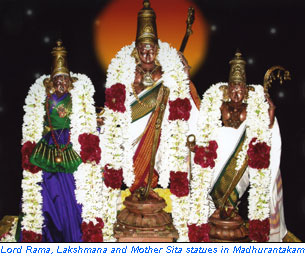 India Company. Though a devout Christian, Col. Price decided to give Lord Rama a try and silently prayed: India Company. Though a devout Christian, Col. Price decided to give Lord Rama a try and silently prayed:
“O Lord Rama, they say You are great. In that case, please come to the rescue of all of us and save everyone by preventing the lake from breaching. If You respond to my prayers, I shall, as an expression of my gratitude, build a temple for Your Consort.”
The moment Col. Price concluded his prayer, there was a flash of lightning, and he had a vision of Rama and Lakshmana smiling! Astounded, he simply cried, “Look there!” and immediately fainted.
When he regained consciousness, Col. Price found himself in a comfortable bed in his own quarters, surrounded by his minions. He sat up with a start and demanded to know the latest position about the tank. He was told that miraculously the rains stopped suddenly, besides which the water level in the lake came down abruptly to a safe level. Col. Price felt relieved, ecstatic and most grateful to the Lord who had come to the rescue in such a dramatic fashion.
Not only Price but also the people of Madurantakam realised that it was Lord Rama who had come to their rescue. Thus it is that even today the temple deity is not referred to as just Rama but as Rama who protected the tank - "Eri Katha Ramar".
|
|
|
|
As for the Colonel, he duly kept his promise and did have a temple constructed for Mother Sita. In fact, there may be found to this day, an inscription in Tamil and Telugu that the temple was built by Company Collector Lionel Place. [The person who did the engraving apparently got the name wrong!] There is also a small representation of the Colonel himself, apparently in his official uniform. |
| Statue of Col. Price |
| |
Inscription recording the donation made by Col. Price |
|
The temple has a serene atmosphere, and is a wonderful place to visit. A unique feature is that on the walls of the temple may be found the devotional songs composed by Saint Tyagaraja, a great poet-saint of south India, in praise of Lord Rama. |
|
That really is the message - Nature is like your dear mother, respect her and love her. She will do everything for you, but approach her with reverence and humility. This is enshrined incidentally in a most wonderful way in the 22nd hymn of the 9th Chapter of the Gita, where Lord Krishna says to Arjuna,
‘As for those who exclusively worship Me, who meditate on Me with no other thought and who are ever steadfast - I bear entirely the burden of their welfare.’
We want to draw your attention to this word of God, and the Katrina disaster has provided an opportunity to do so. By the way, Swami refers to this hymn as the fulcrum of the Gita – it occurs right in the middle!
Praying to Swami that all of us in the Sai family and the world at large would learn this lesson.
- The Heart2Heart Team
ACKNOWLEDGMENTS
Heart2Heart wishes to record its indebtedness to the many sources from which information was drawn for preparing the special feature on Hurricane Katrina. The hurricane photos came to us from devotees. H2H invokes God’s blessings on all the photographers who captured poignant moments, every one of which is a powerful reminder, as former US President Clinton said after the recent tsunami, that someone else is in charge! The graphics illustrating the course of the Missisippi River in New Orleans and how the city lies at a lower level etc., are courtesy of Scientific American. All the photos of Madurantakam have been provided by the District President, Kanchipuram, Tamil Nadu.
|
|
|
|
|












 Into the bowl in which New Orleans once sat in all its glory, water first poured in from the lake and the river. This water drowned most of the city and as a result, there was a lot of oil pollution, oil from drowned trucks and cars, oil from furnaces in the houses, oil from factories, oil that had leaked from refineries that had suffered damage and so on.
Into the bowl in which New Orleans once sat in all its glory, water first poured in from the lake and the river. This water drowned most of the city and as a result, there was a lot of oil pollution, oil from drowned trucks and cars, oil from furnaces in the houses, oil from factories, oil that had leaked from refineries that had suffered damage and so on.





 Madurantakam is a small town about seventy kilometres to the south of Chennai [formerly Madras], located on National Highway 45 connecting Chennai with Kanyakumari, the southernmost point of India. There is rich folklore associated with this place and it is said that Lord Rama Himself visited it, while wandering in search of His Consort Sita. There is big tank in the neighbourhood, and Rama is supposed to have had a bath there while visiting the place. In later years, a temple for Rama was duly established.
Madurantakam is a small town about seventy kilometres to the south of Chennai [formerly Madras], located on National Highway 45 connecting Chennai with Kanyakumari, the southernmost point of India. There is rich folklore associated with this place and it is said that Lord Rama Himself visited it, while wandering in search of His Consort Sita. There is big tank in the neighbourhood, and Rama is supposed to have had a bath there while visiting the place. In later years, a temple for Rama was duly established.
 India Company. Though a devout Christian, Col. Price decided to give Lord Rama a try and silently prayed:
India Company. Though a devout Christian, Col. Price decided to give Lord Rama a try and silently prayed: 